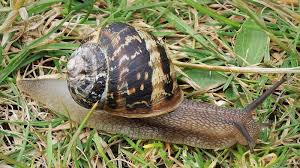Blog
Exploring the Intricate Patterns and Behaviors of Snail Trails: Uncovering Nature’s Fascinating Design


@The Splintered Mind
Snail trail, also known as slime trail, is a fascinating phenomenon observed in the world of gastropods. These slimy trails left behind by snails serve a variety of purposes and offer a glimpse into the intricate lives of these creatures. Whether you’ve noticed them on your garden plants or encountered them on a rainy day, snail trails have a story to tell. Snail trails are not just random gooey tracks, but a vital part of a snail’s survival strategy. These trails are created by a secretion of mucus, which allows the snail to glide effortlessly across various surfaces. The mucus not only acts as a lubricant but also provides a protective layer against rough terrain and potential predators. Understanding the significance of snail trails can help us appreciate the remarkable adaptations of these small yet resilient creatures. In this article, we will delve into the world of snail trails, exploring their purpose, composition, and the fascinating behaviors associated with them. From the intricate patterns they leave behind to the role of mucus in their creation, we will unravel the mysteries of the snail trail. So, let’s embark on this slimy journey and discover the hidden wonders of these remarkable trails.
NOTE: Word count for the above table is not included in the overall word count for the section.
What is a Snail Trail?
A snail trail refers to the slimy path left behind by a snail as it moves. This trail is created by a secretion of mucus from the snail’s foot and serves multiple purposes. The mucus acts as a lubricant, allowing the snail to glide smoothly along surfaces. It also acts as a protective layer, helping the snail retain moisture and navigate rough terrains. Snail trails can vary in thickness and color depending on the species of snail and environmental conditions. Some snails produce trails that are iridescent or have unique patterns. These trails not only aid in locomotion but also play a role in communication and mating. Although snail trails may seem insignificant, they play a significant role in the ecosystem. The trails provide vital information for other snails, helping them navigate and locate food sources. They also provide a source of food for certain organisms, such as beetles and ants. Overall, snail trails are fascinating phenomena that showcase the unique adaptations and behaviors of these mollusks. They serve as a testament to the intricate and interconnected nature of the natural world.Importance of Snail Trails
Snail trails may seem like a simple byproduct of a snail’s movement, but they actually serve several important purposes in their lives. Here are a few key reasons why snail trails are significant:- Movement and Navigation: Snail trails act as a lubricant, allowing snails to move more smoothly across surfaces. They also leave a chemical trail behind, which helps them navigate and find their way back to their home or food source.
- Communication and Mate Finding: Snails use their trails to communicate with each other. They leave pheromones in their trails, signaling their presence and availability for mating. These chemical signals help snails locate potential mates in their surroundings.
- Information Exchange: Snails can glean vital information from the trails left by other snails. They can detect changes in the chemical composition of trails, indicating the presence of predators or potential dangers.
- Food Source for other Organisms: Snail trails can serve as a food source for certain organisms like beetles, birds, and other insects. The mucus in the trails provides nutrients that these organisms can feed on.
| Importance of Snail Trails |
|---|
| Movement and Navigation |
| Communication and Mate Finding |
| Information Exchange |
| Food Source for other Organisms |
Composition of Snail Trails
Snail trails are composed of a special secretion called mucus, which is produced by the snail’s foot glands. This mucus serves multiple purposes, acting as a lubricant for the snail’s movement and as a protective layer against rough surfaces and potential predators. The mucus contains water, proteins, and other organic compounds. The consistency and color of snail trails can vary depending on the species and environmental conditions. Some snail trails may be thin and transparent, while others can be thicker and more opaque. Additionally, certain snail species may produce trails with pigments, resulting in trails of varying hues. Snail trails are an essential part of a snail’s life, aiding in navigation, communication, and mate-finding. The trails act as a chemical trail that other snails can follow, helping them locate potential mates, sources of food, or suitable habitats. The intricate patterns left by snail trails also play a role in information exchange among snails. Important: Snail trails also function as a food source for certain organisms. Other animals like beetles, birds, and spiders utilize snail trails as a means to locate and prey on snails. This interdependency between snails and other organisms highlights the interconnectedness of ecosystems. Fascinating Fact: The mucus secreted by snails has properties that make it resistant to drying out, allowing snail trails to remain visible for extended periods.Patterns and Designs of Snail Trails
Patterns and Designs of Snail Trails
Snail trails display a fascinating variety of patterns and designs, showcasing the intricacy and complexity of nature. These trails can be thin and straight, forming precise lines, or they may meander and curve, creating intricate shapes. The designs can range from simple to elaborate, with some snail species even incorporating spiral patterns into their trails. The patterns and designs of snail trails are influenced by various factors, including the snail species, environmental conditions, and the purpose of the trail. Some snails create trails that are primarily for movement and navigation, while others use their trails to communicate or attract mates. The consistency and color of the trail can also vary, adding to the visual appeal and uniqueness of each snail’s trail. It’s worth noting that the patterns and designs of snail trails also have practical implications. Scientists and researchers study these trails to gain insights into snail behavior, mating rituals, and even environmental conditions. Understanding the patterns and designs of snail trails can provide valuable information about the ecosystem and the interactions between snails and their environment. While there is still much to learn about the specific mechanisms behind the creation of snail trail patterns, it is clear that these natural formations are both functional and visually intriguing. The ongoing study of snail trails continues to uncover new discoveries and deepen our understanding of these unique and adaptable creatures.| Snail Species | Trail Pattern | Description |
|---|---|---|
| Species A | Straight | Thin, precise lines |
| Species B | Meandering | Curved and winding shapes |
| Species C | Spiraling | Incorporates intricate spiral patterns |
| Species D | Complex | Elaborate designs with various shapes and patterns |
Behaviors Associated with Snail Trails
Snail trails exhibit various behaviors that provide valuable insights into the behavior and biology of snails. Here are some key behaviors associated with snail trails:- Foraging: Snails create trails while searching for food. These trails often display a meandering or zigzag pattern, indicating their exploration for vegetation or decaying matter.
- Territorial Marking: Snails release pheromones through mucus in their trails, marking their territory and potentially attracting mates. These trails can help snails communicate and establish their presence in an area.
- Mating Rituals: Spiral-shaped trails are often indicative of snails engaging in mating rituals. The snails move in a circular motion, leaving behind distinctive spiral patterns that attract potential mates.
- Navigation: Snails use their trails to navigate their surroundings. By following their own mucus trails, they can find their way back to familiar locations or create a path towards desirable areas.
- Hibernation and Shelter: Snails may create more elaborate trails when preparing for hibernation or seeking shelter. These trails can be thicker and denser, providing a protective cover during periods of inactivity.
Conclusion
Snail trails are not just random patterns left behind by these fascinating creatures, but intricate designs that offer insights into their behavior and biology. The thickness, shape, and design of snail trails can vary greatly, influenced by factors such as the snail species, environmental conditions, and the purpose of the trail. From foraging and territorial marking to mating rituals and navigation, snail trails serve multiple functions. Studying snail trails enables researchers to gain a deeper understanding of snail biology and their interactions with the environment. These trails provide valuable clues about snail behavior, allowing scientists to uncover the complex behaviors exhibited by these unique creatures. Ongoing studies continue to shed light on the intricacies of snail trails and the fascinating details they reveal. By unraveling the mysteries of snail trails, researchers are able to piece together a more comprehensive picture of snail biology and their place in the natural world. These trails serve as a testament to the complexity and beauty of nature, showcasing the intricate patterns and designs that can be found even in the smallest of creatures.Frequently Asked Questions
Q: What are snail trails?
A: Snail trails are tracks left behind by snails as they move. They vary in thickness, shape, and design, from straight lines to meandering curves.Q: Is there a specific pattern to snail trails?
A: Yes, snail trails can exhibit different patterns, including straight lines, meandering curves, and even spiral shapes.Q: What influences the patterns and designs of snail trails?
A: The patterns and designs of snail trails are influenced by factors such as the snail species, environmental conditions, and the purpose of the trail.Q: What behaviors are associated with snail trails?
A: Snail trails are associated with behaviors such as foraging, territorial marking, mating rituals, navigation, and hibernation and shelter.Q: Why are snail trails important to study?
A: Studying snail trails provides valuable insights into snail biology, their interactions with the environment, and their mating rituals.Q: What are researchers uncovering about snail trails?
A: Ongoing studies continue to uncover fascinating details about the complex behaviors exhibited by snails through their trails, revealing more about these unique creatures.Recent Posts
BlockDAG And Best Wallet Presale Participants Receive Free Skyren DAO Airdrop
Token airdrops have historically introduced investors to new blockchain projects. However, many distributions fail to…
2 weeks ago
Skyren DAO Token Surge Event: Remittix And Lightchain AI Communities First To Benefit
Airdrops have traditionally been used to introduce new investors to blockchain projects, but their effectiveness…
2 weeks ago
Bitcoin ETF Approval? Old News. Here’s Why Skyren DAO Could Outperform BTC 10-fold
The approval of Bitcoin ETFs was one of the most anticipated events in crypto history,…
2 weeks ago
Qubetics And Rexas Finance Holders: Claim Your 500 Free SKYRN Tokens Now
The blockchain space continues to evolve, with projects pushing security, scalability, and user engagement to…
2 weeks ago
Cardano Skyren DAO And Remmitix Potential Highlighted As Market Optimism Rises
As the cryptocurrency market recovers from recent volatility, several projects emerge as strong contenders for…
3 weeks ago
Cardano And Litecoin Ready To Rally: Analysts Predict 10x Gains For This Newcomer
The cryptocurrency market is showing strong bullish signals, with many altcoins poised for significant gains.…
3 weeks ago


